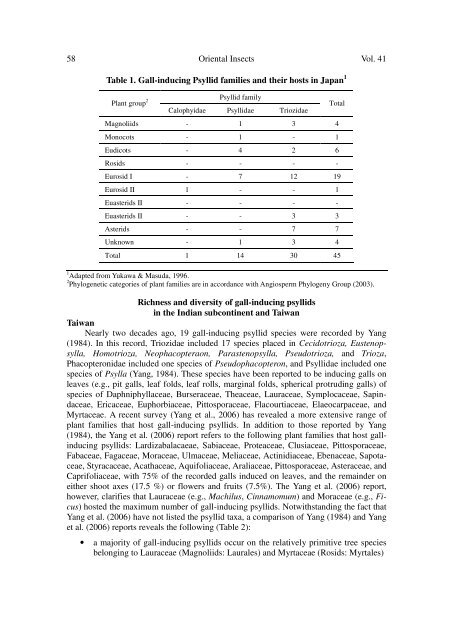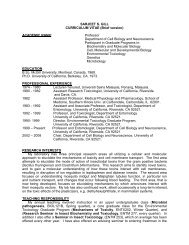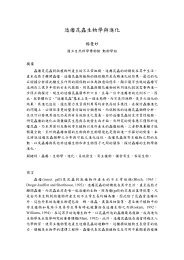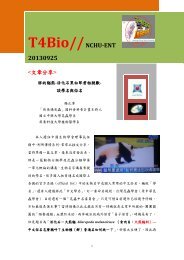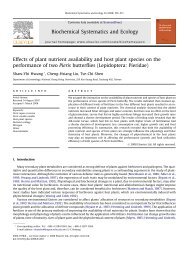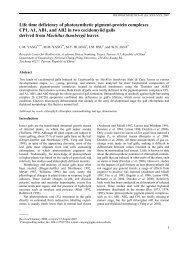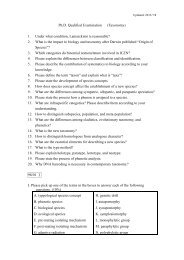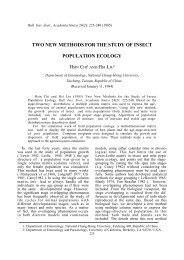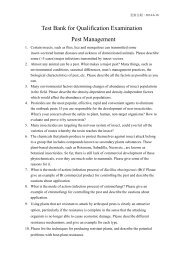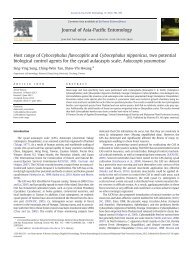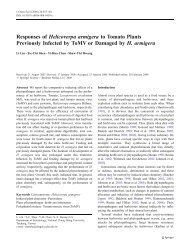diversity, richness, and patterns of radiation among gall-inducing ...
diversity, richness, and patterns of radiation among gall-inducing ...
diversity, richness, and patterns of radiation among gall-inducing ...
Create successful ePaper yourself
Turn your PDF publications into a flip-book with our unique Google optimized e-Paper software.
58 Oriental Insects Vol. 41Table 1. Gall-<strong>inducing</strong> Psyllid families <strong>and</strong> their hosts in Japan 1Psyllid familyPlant group 2 Calophyidae Psyllidae TriozidaeTotalMagnoliids - 1 3 4Monocots - 1 - 1Eudicots - 4 2 6Rosids - - - -Eurosid I - 7 12 19Eurosid II 1 - - 1Euasterids II - - - -Euasterids II - - 3 3Asterids - - 7 7Unknown - 1 3 4Total 1 14 30 451 Adapted from Yukawa & Masuda, 1996.2 Phylogenetic categories <strong>of</strong> plant families are in accordance with Angiosperm Phylogeny Group (2003).Richness <strong>and</strong> <strong>diversity</strong> <strong>of</strong> <strong>gall</strong>-<strong>inducing</strong> psyllidsin the Indian subcontinent <strong>and</strong> TaiwanTaiwanNearly two decades ago, 19 <strong>gall</strong>-<strong>inducing</strong> psyllid species were recorded by Yang(1984). In this record, Triozidae included 17 species placed in Cecidotrioza, Eustenopsylla,Homotrioza, Neophacopteraon, Parastenopsylla, Pseudotrioza, <strong>and</strong> Trioza,Phacopteronidae included one species <strong>of</strong> Pseudophacopteron, <strong>and</strong> Psyllidae included onespecies <strong>of</strong> Psylla (Yang, 1984). These species have been reported to be <strong>inducing</strong> <strong>gall</strong>s onleaves (e.g., pit <strong>gall</strong>s, leaf folds, leaf rolls, marginal folds, spherical protruding <strong>gall</strong>s) <strong>of</strong>species <strong>of</strong> Daphniphyllaceae, Burseraceae, Theaceae, Lauraceae, Symplocaceae, Sapindaceae,Ericaceae, Euphorbiaceae, Pittosporaceae, Flacourtiaceae, Elaeocarpaceae, <strong>and</strong>Myrtaceae. A recent survey (Yang et al., 2006) has revealed a more extensive range <strong>of</strong>plant families that host <strong>gall</strong>-<strong>inducing</strong> psyllids. In addition to those reported by Yang(1984), the Yang et al. (2006) report refers to the following plant families that host <strong>gall</strong><strong>inducing</strong>psyllids: Lardizabalacaeae, Sabiaceae, Proteaceae, Clusiaceae, Pittosporaceae,Fabaceae, Fagaceae, Moraceae, Ulmaceae, Meliaceae, Actinidiaceae, Ebenaceae, Sapotaceae,Styracaceae, Acathaceae, Aquifoliaceae, Araliaceae, Pittosporaceae, Asteraceae, <strong>and</strong>Caprifoliaceae, with 75% <strong>of</strong> the recorded <strong>gall</strong>s induced on leaves, <strong>and</strong> the remainder oneither shoot axes (17.5 %) or flowers <strong>and</strong> fruits (7.5%). The Yang et al. (2006) report,however, clarifies that Lauraceae (e.g., Machilus, Cinnamomum) <strong>and</strong> Moraceae (e.g., Ficus)hosted the maximum number <strong>of</strong> <strong>gall</strong>-<strong>inducing</strong> psyllids. Notwithst<strong>and</strong>ing the fact thatYang et al. (2006) have not listed the psyllid taxa, a comparison <strong>of</strong> Yang (1984) <strong>and</strong> Yanget al. (2006) reports reveals the following (Table 2):• a majority <strong>of</strong> <strong>gall</strong>-<strong>inducing</strong> psyllids occur on the relatively primitive tree speciesbelonging to Lauraceae (Magnoliids: Laurales) <strong>and</strong> Myrtaceae (Rosids: Myrtales)


